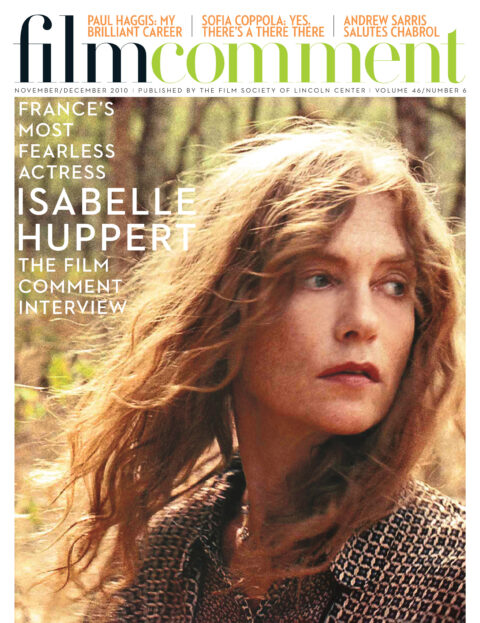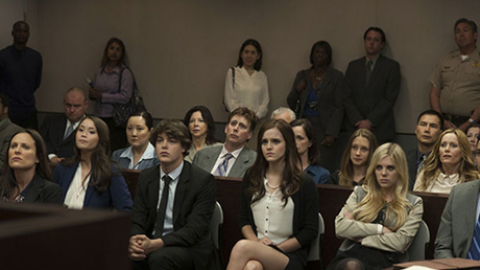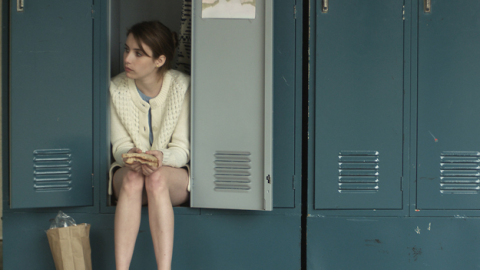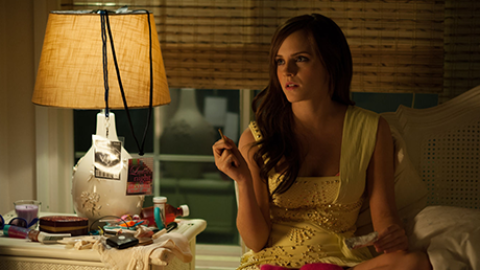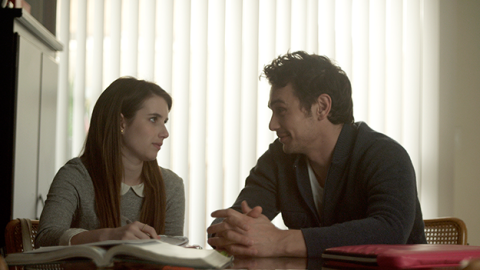
“I’m kind of a mumbler,” says Sofia Coppola in a noisy Soho restaurant, looking a tad concerned at her interviewer’s digital recorder. It was an apt beginning for a conversation about a new movie concerned with finding peace of mind, made by a director whose work has been dismissed as vague, insubstantial, and worse. Many critics jumped ship with the “vapid excess” of Marie Antoinette (06); Film Comment put it on the cover, but the accompanying article opened with the author delineating the limits to his admiration. Four years on, Coppola’s latest, Somewhere, faces the unenviable task of proving to skeptics that there is a there there, and over the course of an enjoyable interview, it would be hard to tell whether her on-message answers came out of wanting the film to speak for itself—or out of wariness.
Somewhere is a modest picture set in an immodest milieu—an unbroken portrait of a burning-out movie star within which is nested a warmer, more intuitive depiction of a father-daughter relationship. Opening with an extended shot of a Ferrari circling a closed circuit, and characterized by plenty of hanging out in hotel suites, it is probably not going to convert the haters. Which is a pity, since the natural affection between Chateau Marmont guest resident Johnny Marco (Stephen Dorff) and Cleo (Elle Fanning), his sweet, precocious 11-year-old, is persuasive and cozily felt like almost no other connection in Coppola’s disconnect-marked oeuvre.
“I started out with this bad-boy actor having this crisis, and then the character of the daughter just came into it, and I was thinking about it because I just had my first child,” said Coppola, who took time off between films to spend time with her first daughter, and wrote the original screenplay while living in Paris. “I was thinking about people with that lifestyle and kids, just the contrast of the two worlds, and what that might be like.”

Johnny, tousle-haired and sidelined by a broken arm (a party injury), finds himself taking care of Cleo, who is ordinarily in the charge of his ex-wife. A star coasting through stupid movies, at every turn he encounters women who want to sleep with him, to the point of parody: it’s so mundane to him that during one sexual episode he falls asleep. But despite being a complacent horndog and something of a weekend Santa to his daughter, he’s a warm and attentive father in the moment, full of praise after watching her ice-skating routine. Childrearing has its perils—there’s more than one near-farcical close call with groupies, and Cleo’s ice-skating demo comes chronologically between two scenes in which twin pole-dancers perform for Johnny in his hotel room. But the easy narrative gambit of an inappropriate encounter and father-daughter confrontation never materializes.
In fact, it’s a notably tender portrait, buoyed by Dorff and Fanning’s underplayed charm. Yet that very paternal relationship, against the backdrop of the celebrity-and-Chateau-Marmont scene, may only trigger Coppola skeptics, who see entitlement in her career and subject matter alike. With her fourth feature film, the 39-year-old writer-director admits continued echoes from her own life as the daughter of someone famous, but draws firm distinctions.
“Johnny is so different than my Dad obviously, but definitely I know what it’s like to be around a Dad with all that attention or whatever. My Dad would take us on adventures, we’d go on a helicopter with him,” says Sofia. Just as Johnny does with Cleo, Dad taught Sofia how to play craps at a casino. But: “I don’t think it’s autobiographical. I think all writers use what they know. But I think ‘autobiographical’ would be more if it were more similar to my background. I think it’s easy to say that.”

Far from being a handicap, Somewhere’s star-struck setting furnishes its most potent insight: the common ground shared by a celebrity and a tween, by life in the limelight and being on the cusp of adolescence. Both conditions entail feeling overexposed, enduring a focus on your body and your age, wanting attention, not wanting attention, gaining agency. Early in the film, Johnny is called in to sit for a makeup mask molding; mummified in plaster goop, he’s in a state of maximal indignity, reduced to just a body. Good-natured Cleo is anything but the average pouty movie teen, but Fanning’s by turns gawky and graceful frame alone speaks volumes about a girl at a delicate moment of transition.
In this light, the standard line on Marie Antoinette might be amended: that anachronistic romp wasn’t suggesting that the queen was just another spoiled teen, but on the contrary—that adolescence can seem like an it’s-my-party fantasy with high-stakes, high-drama reverberating through a royal court. With Somewhere Coppola tracks in on youth from a different angle, on a smaller scale: “After Marie Antoinette, which was so girlie, I definitely wanted to do something minimal and from a guy’s point of view, probably just because I overdosed on frilly girliness.”
“Minimalism” for Coppola means the aforementioned long takes, the slightly astringent light of Los Angeles, directing Dorff and Fanning to take a less-is-more approach—Guitar Hero play sessions and comfort-food togetherness in place of dramatic turning points and face-offs. The overall mood is that of a prolonged summer vacation, one day lazing into the next, every activity a series of impromptus. It’s the height of excitement when, with typical Coppola bemusement, Johnny whisks Cleo off to Milan, where he accepts an accolade at an over-the-top awards show (and must stand there while dancers sing and twirl round him onstage).

“I just wanted to see how simply I could tell a story,” says Sofia, whose DP was Harris Savides, fresh from shooting Greenberg. “I was talking a lot to Harris. We shot a commercial before I started writing the script. We were talking about movies and what we didn’t like about shooting. We started talking about how much we hate having to do coverage. And we were talking about how you don’t need to do that, and how simply you can tell a story.”
One wag dubbed Somewhere’s stretches of suspension as Coppola’s stab at “slow cinema.” (“Is that like slow food?” she asks. “Yeah, super-Euro…”) But the observational approach is a natural outgrowth of the act of watching (by audience and among characters) that’s so rife in Coppola’s films, and here it yields dividends. When Cleo finds a strange woman (an old flame) at breakfast with Dad during the Italy trip, her pointed glances across the table take the place of an outburst. Likewise, there’s something ineffably sweet about father and daughter just lying on pool-side sunbeds listening to music (“I’ll Try Anything Once” by the Strokes), or Cleo falling asleep on his shoulder in a hotel lobby.
None of this would be bearable for very long without the easy, relaxed appeal of its leads. Coppola’s casting of Dorff is a minor feat of career resurrection: an actor plucked from the C-list, planted in an unexpected role, and allowed to bloom. Without breaking a sweat he portrays a challenging character: someone who knows that he needs to take time out to reflect and take stock, but seems unable to pause for it as he heads towards a seemingly inevitable crisis. Johnny’s approach to relationships unsurprisingly leaves a trail of bitterness strewn behind, and for director and actor, a little preparation went a long way toward establishing the undercurrent before shooting began: “We did a lot of really dramatic rehearsals so that when the ex-wife [Cleo’s mother] comes, they barely say anything, but there’s a whole thing going on that’s unsaid.”
Embodying a talented girl full of potential and life, Fanning provides a poignant counterpoint to her water-treading Dad. Despite being part of the Fanning acting clan, the actress projects the genuineness and appeal of a nonprofessional. Subjected to teasing by Dad’s rangy pal (played by Chris Pontius of Jackass fame), her face crinkles with a slightly embarrassed-delighted smile that she holds a beat too long, perfect for the moment.

Still, the actors seemed an afterthought when the film won the Golden Lion at Venice in September from a jury led by Quentin Tarantino—an honor immediately called out as scandalous favoritism for what was taken as either an unremarkable or “typically Hollywood” entry. Coppola diplomatically views the award as an “encouraging” surprise for what she calls “a small personal film” but welcomes the strong reactions. “Some people get into it and then other people don’t at all. But I think that’s better than being just kind of mediocre,” she says. “That would be the worst.”
Ambitiously, Somewhere’s close conjures something of the same order as Bill Murray’s whispered words to Scarlett Johansson at the end of Lost in Translation. Johnny makes a decision that regretfully confirms the limits to his parenting, but is followed by a bid to find a new direction in life that starts with an enigmatic car trip into the desert (topped off with an uplifting track from Phoenix, whose front-man is Sofia’s partner). Open-ended—to a point: “I like endings where you get to think about what happens but you give an indication. To me it’s frustrating when there’s no indication. Like you’ve watched the whole movie and they don’t give you anything.”
Coppola’s sentiment came to mind anew towards the end of the interview, when conversation turned to movies in current release. After mentioning that she’d just watched Caché, she quickly became curious about another film with a fraught ending: the dicey Facebook-fakery documentary Catfish. Was there a surprise at the end, was it worth seeing? “I’m kind of curious, but maybe if it’s fake, it seems boring,” she mused. “Is it real? Is that part real?” Naysayers may ask the same of Coppola’s latest film. Does it deliver something emotionally authentic or is it yet more elegantly wasted artifice? But for its moments of tenderness, Somewhere is one Coppola film worth taking at face value.



